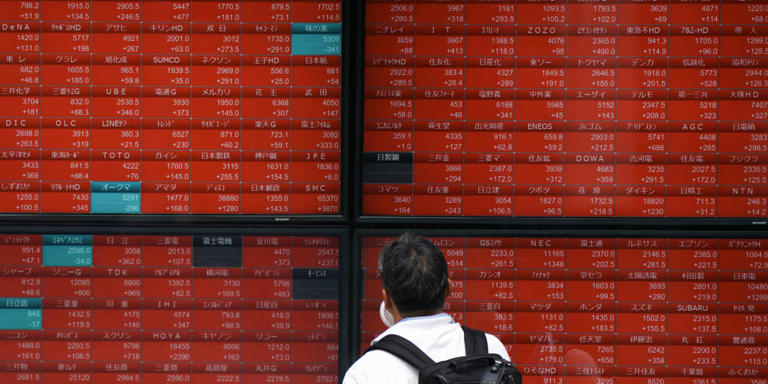The beginning of the week on August 5, 2024, was marked by a dramatic market sell-off that reverberated globally, reminiscent of the financial panic seen during the 1987 crash. As fears over a weakening U.S. economy escalated, global markets took a significant hit. On Wall Street, the S&P 500 experienced its most significant decline in nearly two years, dropping by 3%. The Dow Jones Industrial Average plummeted by 1,033 points, or 2.6%, while the Nasdaq Composite fell 3.4%. The technology sector, which had been a leading force in the market, was particularly hard-hit. Stocks from major tech firms such as Apple and Nvidia led the declines, reflecting broader anxieties about future economic growth and the high valuation of tech stocks.
Nikkei 225’s Sharp Decline
In Asia, Japan’s Nikkei 225 index opened the week with a severe drop of 12.4%. This was a reaction to Friday’s U.S. jobs report, which showed that U.S. employers had significantly slowed their hiring, raising concerns about the health of the American economy. This data contributed to fears that the Federal Reserve’s stringent monetary policy aimed at controlling inflation might be excessively slowing economic growth. Investors in Japan and other Asian markets reacted to these fears with widespread selling.
A Remarkable Rebound
On August 6, 2024, the Nikkei 225 made a remarkable recovery, surging more than 10% early in the trading session. This rebound was a stark contrast to the previous day’s dramatic fall. At one point, the index had climbed nearly 11% before stabilizing at an 8.7% increase, reaching 34,211.83. This resurgence was driven by investors seizing perceived bargains following the sharp sell-off. The rebound reflects a partial recovery of market sentiment as traders looked to capitalize on the lower stock prices created by the previous day’s turmoil.
Broader Asian Market Response
The recovery in Japan provided a boost to other Asian markets, which also experienced positive movements. South Korea’s Kospi index rose by 3%, and markets in Hong Kong, Shanghai, Taiwan, and Sydney showed smaller but notable gains. This broader positive movement indicates that investors across Asia were beginning to stabilize and reassess their positions after the initial shock.
Underlying Factors Driving Market Turmoil
The global market turmoil can be attributed to several interconnected factors:
- U.S. Economic Data: The U.S. jobs report released on Friday showed a significant slowdown in hiring, which added to existing fears about the U.S. economy. This data suggested that the Federal Reserve’s high-interest rate policies might be overly restrictive, potentially stifling economic growth. The market reacted sharply to this information, contributing to the widespread sell-off.
- Bank of Japan’s Policy Shift: The Bank of Japan’s decision to raise its main interest rate from nearly zero last week had significant implications. While intended to strengthen the Japanese yen, this policy shift also created turbulence in global markets. Traders who had previously borrowed money at low rates in Japan and invested it elsewhere faced pressures to unwind these positions, exacerbating market volatility.
- Market Sentiment and Bargain Hunting: The steep declines in stock prices created opportunities for investors to buy at lower prices. The Nikkei 225’s recovery illustrates how markets can rebound when investors see value in stocks that had been oversold. This sentiment contributed to the positive movement in the Nikkei and other Asian indices.
Outlook and Considerations
As markets move forward, several factors will be crucial in determining their direction:
- Economic Data: Ongoing economic data from the U.S. and other major economies will be closely monitored. Indicators such as employment figures, consumer spending, and inflation will provide insights into the health of the economy and the effectiveness of monetary policies.
- Monetary Policy: The actions of central banks, including the Federal Reserve and the Bank of Japan, will continue to influence global markets. Investors will be attentive to any further changes in interest rates or monetary policy adjustments that could impact economic growth and market stability.
- Market Valuations: The recent declines in major indices and tech stocks have led to questions about market valuations. Analysts will assess whether current stock prices are reflective of true value or if further adjustments are needed. The ability of companies to deliver strong earnings growth will be a key factor in restoring investor confidence.
Geopolitical and Economic Risks
In addition to economic data and monetary policy, broader geopolitical risks will also play a role. The ongoing Israel-Hamas conflict, potential fluctuations in oil prices, and uncertainties surrounding upcoming U.S. elections could add to market volatility. These factors may influence economic conditions and investor sentiment, potentially affecting market stability.
Overall, while the Nikkei 225’s recovery offers a glimmer of hope amidst the global market turmoil, the underlying concerns about economic growth, monetary policy, and geopolitical risks will continue to shape market dynamics in the near term. Investors and analysts will need to navigate these complexities to make informed decisions as the situation evolves.
